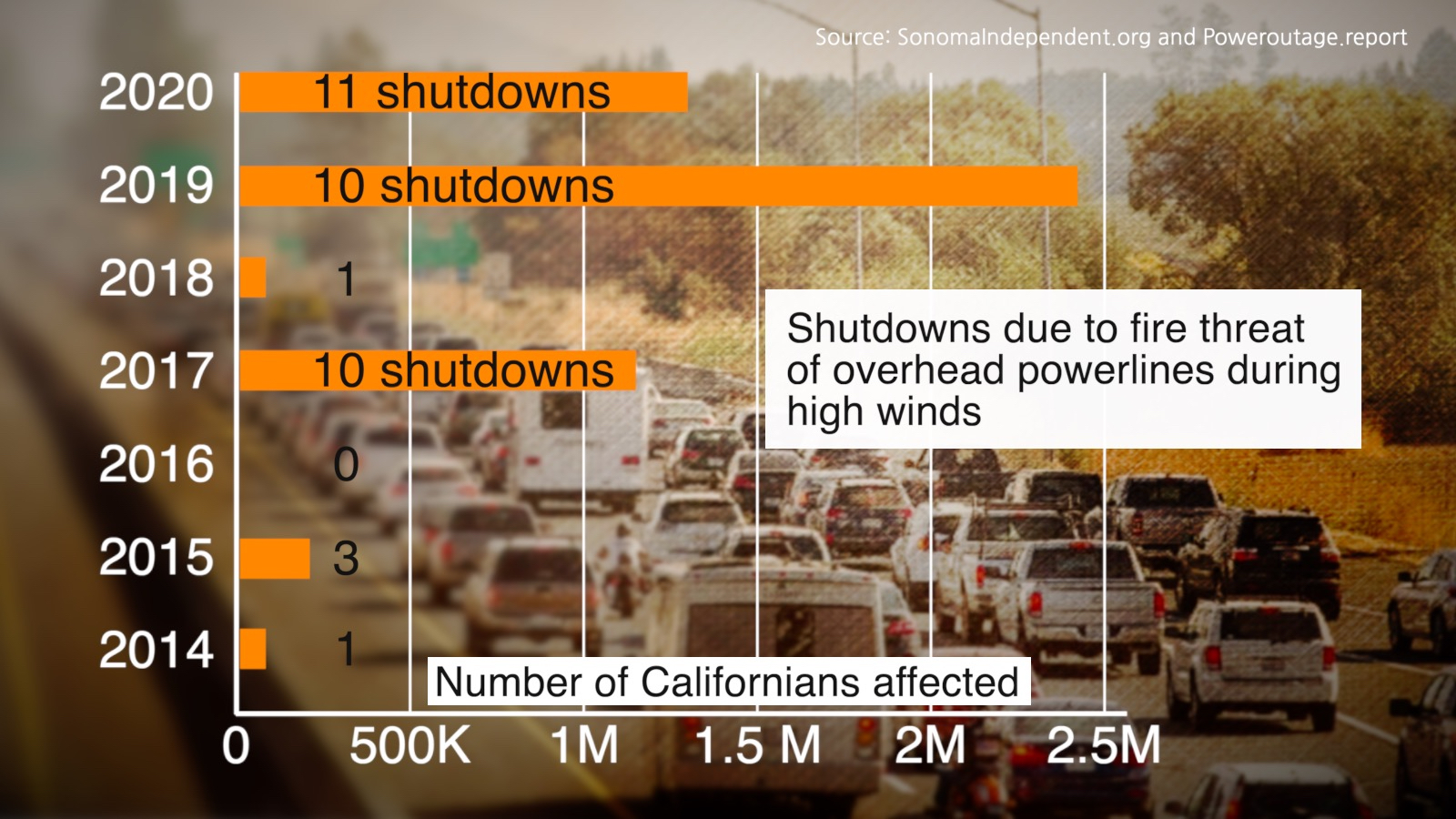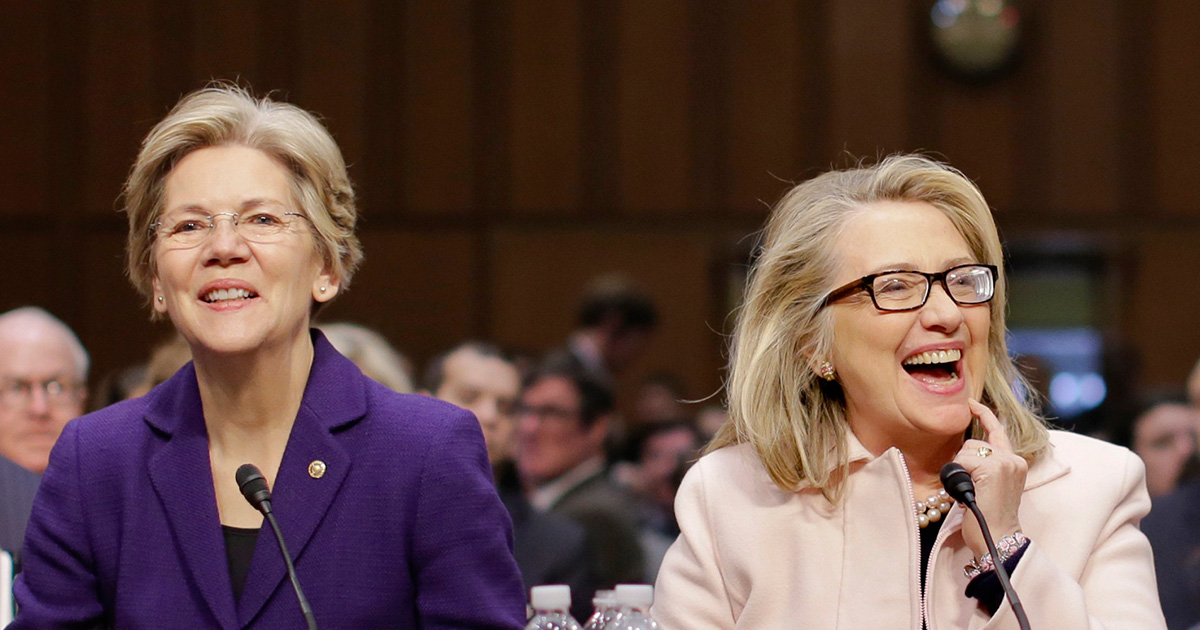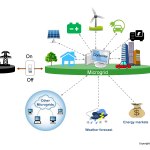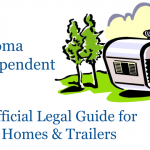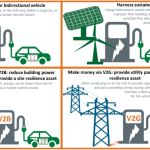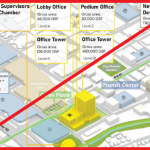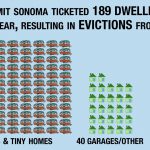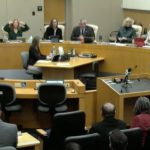We’ve heard it a thousand times. Climate change has created record heat, historic drought and the unusually high winds. As experts plan for an even worse fire season than last, Californians can expect liability-averse utility companies PG&E and SCE to order more frequent and larger power shutdowns than last year, to avoid the ever-increasing number of fires caused by overhead power lines damaged by high winds.
We are also told that there is nothing that can be done to prevent these shutdowns, which is why the Sonoma Independent has launched a grassroots campaign and petition (please sign it here!) to compel our state legislators to use just 2% of our unexpected $76 billion surplus to bury the most geographically hazardous overhead power and transmission lines that have caused four of the worst fires in the past four years, including the 2018 Camp Fire (around Paradise), the deadliest and most destructive in California history.
As the graphic accompanying this article demonstrates, the pre-emptive power shutdowns ordered by the state’s utility giants disrupted the lives, livelihoods and schools more than 2.5 million Californians last year, causing special suffering for our elderly and infirm neighbors, who depend on steady electricity for life-sustaining machinery.
Yet time and time again, Californians have been told that burying these overhead fire-causing lines so the pre-emptive power shutdowns become unnecessary, because underground lines are safe in high winds, is out of the question because, because is simply too expensive to do so.
Welcome to the world of Fire Prevention Fake News, brought to us by the State of California, PG&E, SoCal Electric, public relations pros and thousands of public officials whose role it is to manage, by diminishing, the expectations” of we, the people, who pay their salaries, so that we do not ask for something they are not prepared to deliver.
Call it California’s Big Fire Prevention Lie: “We can’t afford to bury ALL of the state’s overhead power lines, so we can’t afford to bury ANY of them.”
A few years ago, a widely-cited BloombergNEF report estimated that just burying all of PG&E’s 81,000 miles of overhead lines would cost a whopping $240 billion. Which, politicians and experts have told us, is far more money than we can ever afford.
The operative, and deceptive word here is “all.”
Because there is no need to bury all of PG&E overhead power lines in California. See our map below showing where the overhead power-line caused California fires since 2017 occurred, and it becomes clear that the area around them comprises a tiny portion of the state’s land. Burying just 500 miles of the highest risk area, high wind areas would require work on less than 1/4 of 1% of all the state’s overhead lines. But it could prevent most, if not all, of the power shutdowns and many of the worst fires.
Last year Ephram Glass and his father, Victor Glass, a Rutgers Professor of Professional Practice – Finance and Economics, wrote an important but little known article in T&D World, the journal for the utility industry professionals, in which they dismissed the $240 billion cost estimate. “PG&E’s website page on undergrounding costs could easily mislead someone not familiar with the data,” they wrote. The Glasses found that PG&E vastly inflated the estimated costs of burying power lines in High Fire Threat Districts (HFTD). “Most of the lines in the HFTD areas are rural or suburban lines, not urban. The cost to underground lines in these areas is significantly cheaper than in urban areas because of fewer obstacles and more unpaved rights-of-way.”
Reducing the threat of fires by removing the low hanging fruit of the highest threat 500 miles of overhead lines, which could easily be prioritized by CAL FIRE based on their tracking of hundreds of past fires, would cost less than 2% of the state’s enormous $76 billion budget deficit, which is being voted on by the state legislature on June 15.
The work could start as early as July 1 in Ventura county, around Malibu and Santa Barbara, along with the eight counties surrounding the Camp Fire and Tubbs Fires, the state’s two deadliest). According to PG&E, these eight counties, Butte, Calavaras, Lake, Mendocino, Napa, Nevada, Sonoma and Yuba, contain a TOTAL of just 532 overhead power lines.
This $1.5 billion investment could prevent most of the fires in these two regions, as well as all of the costly power shutdowns mass evacuations prompted by high wind conditions that have become tragically routine for Northern California residents.
“Upgrading infrastructure in high-risk areas is an investment that can save the state billions from expensive disaster recovery efforts while supporting communities most vulnerable to climate change impacts,” says Andrew Truman Kim, Chair of California’s Innovation and Sustainability PAC.
Frequently Asked Questions about our petition, which you can sign here
Q: Do overhead power lines cause fires?
Yes. Overhead power lines have been responsible for the two most destructive fires in California history, the Tubbs fires near Santa Rosa (2017) and the Camp Fire near Paradise (2018), as well as the calamitous Woolsey Fire near Malibu (2018) and Sonoma County’s Glass Fire (2020).
Q: Would the worst fires in California history have happened if the power lines were buried?
No, they would not have happened. Buried power lines are underground, so they never fall down and light dry grass on fire after they are hit by high winds, storms and tree branches flying into them
Q: We can never afford to bury all the overhead power lines, can we?
There is no need to bury all the overhead power lines. Just the most hazardous 500 miles of them, ina relatively tiny area of California. These 500 miles of overhead lines represent just a fraction of 1% of the more than 200,000 miles of overhead lines around the state. We do not need to bury the tens of thousands of miles of densely laid out power lines in cities or suburbs, or the tens of thousands of miles of power lines across the treeless desert, because they do not blow down in high winds and cause fires.
According to PG&E, the counties of Butte, Calavaras, Lake, Mendocino, Napa, Nevada, Sonoma and Yuba, which were home to both the Camp and the Tubbs fires (the state’s two deadliest) contain a total of only 532 overhead power lines. This proposed $1.5 billion appropriation is enough money to bury a total of 500 miles from these areas during the next two years, along with the most hazardous lines around Malibu and Santa Barbara, where windy hills next to dry grassy terrain create similar fire-sparking hazards.
Q: Isn’t California already budgeting enough for fire prevention under the Senate’s Blueprint for a Safe California and Governor Newsom’s increased CAL FIRE budget?
No. Governor Newsom’s recent funding proposal and a package of new bills announced last week by Senator Dodd and six other members of the Senate’s “Wildfire Working Group,” focuses on regulations, preparing for fires by clearing brush to diminish the spread of fires, formulating evacuation plans, making insurance available to farmers and providing the staffing, training and funding to fight fires AFTER they start.
Not a single California tax dollar is being spent on what is by far the most effective way to PREVENT the fires in the first place, which is to bury the fire lines that cause many of them, before they happen.
Q: How would burying the worst power lines impact power shutdowns?
Eliminating overhead lines in fire-prone high wind areas would eliminate the need for PG&E and SCE to preemptively shut down power because of damage-prone rural overhead lines during high winds. These shutdowns, which are happening with increasing frequency, impacted more than 2.5 million Californians last year and are expected to grow this year, which is among the driest and windiest in history.
Q: Would it harm the environment to bury the power lines?
What harms the environment and causes catastrophic carbon emissions are the increasing number of major fires, most of which would have been prevented if the riskiest overhead power loans had been buried. Burying high risk power lines would also end the expanding practice of preemptive power outages, which themselves necessitate the wasting of refrigerated foods and the burning of thousands of tons of carbon from residents forced to relocate. The actual burying of the power lines below the existing overhead lines will disrupt a relatively small amount of land, while permitting trees to grow more freely near where overhead lines necessitate constant trimming.
Q: Why does PG&E need government money to bury overhead lines?
Public utilities like PG&E own the power lines and are responsible for their maintenance. But because their profits are regulated by the state’s Public Utility Regulatory Commission, they are only permitted to budget for the lowest cost of delivering electricity to consumers, regardless of the billions it costs Californians from fires. Because burying power lines can cost four times as much as running lines overhead, PG&E and SCE are not able to pass these costs on to ratepayers, so instead they use the lowest cost method. To avoid liability when their overhead lines cause fires, which they frequently do during high winds, the utility companies preemptively shut down power to increasingly large areas of customers, impacting millions of Californians.
Q: Is this a handout of taxpayer money to PG&E?
This appropriation would not increase profits to PG&E, but it would force PG&E to be part of a solution instead of expanding crippling power shutdowns to avoid liability.
Q: Why shouldn’t PG&E pay part of the cost to bury overhead lines?
They should. That’s why our proposed spending bill, which is being introduced to the Senate and Assembly on June 7, requires utility companies to co-pay $1 for every $2 the state spends to bury overhead lines, and to take that money from their profits instead of increasing rates.
The State’s Public Utility Regulatory commission would oversee the funding to ensure that the allocation did not result in any increased profits for the utilities.
Q: How many jobs would this appropriation create?
During the next two years, PG&E and SCE would use this funding, matched 50% by their own spending, to provide more than 1,500 high-paying union jobs to handle the dangerous line work, Meanwhile, Cal Fire could train and hire more than 5,000 low-skilled workers to help with less skilled but important tasks like operating a back hoe, digging and traffic control.
Q: What happens if legislators do not budget funding to bury overhead lines?
California has a choice: we can stick with the status quo, which means an endless nightmare of destructive wildfires, while allowing PG&E and SCE to expand their pre-emptive power shutdowns for millions of Californians in anticipation of high winds. Or we can fund the burying of 500 of the riskiest miles of overhead lines identified by Cal Fire (based on past fires), and allocate $1.5 billion of new funding from California’s $76 billion budget surplus, alongside $750 million of utility company funding, to pay for it.

